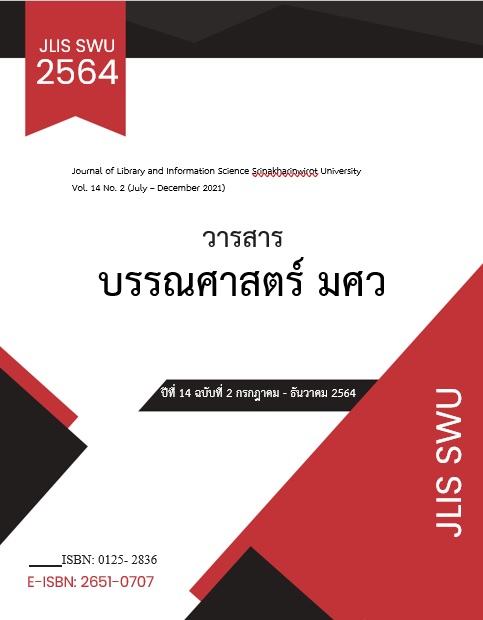Factors Afecting Mobile Information Behavior of Mahasarakham University Students
Keywords:
Mobile information behavior, Factors affecting, Undergraduate student, Mahasarakham UniversityAbstract
The purposes of this study were 1) to study mobile information behavior of Mahasarakham University students, 2) to compare mobile information behavior, and 3) to study factors affecting mobile information behavior. The sample group was 395 Mahasarakham University students enrolled in the first semester of the academic year 2021. Data were collected by using questionnaire and analyzed by using descriptive statistics and the multiple regression analysis.
The results of the study were as follows: 1) the students had mobile information behaviors at a high level. When considering each aspect, it was found that the information need was the most, followed by Information retrieval & use and information access, 2) The comparison on the mobile information behavior of students based on gender, age, year of study, and faculty showed that students from different gender, age, year of study, and faculty did not have any significant on mobile information behavior. However, comparing the mobile information behavior in information retrieval & use with statistically significant at the level of .05, 3) Factors affecting mobile information behavior found that the factors of mobile information behavior associated positive factors with mobile technology acceptance factors, psychological factors, environmental factors, and learning style with a predictive coefficient or predictive power was at 75.5 percent.
References
Arif, Z., Rahman, A. L. A., Ghazali, A. M., & Ghazali, M. F. I. M. (2015). Dimension of Librarians’ Mobile Information Behavior in an Openness Paradigm Era.
Changtong, J., Manmart, L., & Vongprasert, C. (2012). Learning Styles: Factors Affecting lnformation Behavior of Thai Youths. Journal of the Faculty of Arts, Silpakorn University, 34(2), 162-184. (In Thai)
Maslow, A. H. (1954). Motivation and Personlity. New York: Harpers and Row.
Bhat, M. A., & Govil, P. (2014). Understanding Learning Styles of Secondary School Students in Relation to certain Variables. Asian Journal of Multi Discipline, 2(11) November.
Ministry of Education. (2020). Instructional Design. Retrieved June 23, 2020, from https://www.moe.go.th.
National Statistical Office of Thailand. (2020). Ministry of Digital Economy and Society. Retrieved August 8, 2020 from http://www.nso.go.th.
Office of General Education. Mahasarakham University. (2020). Online Instruction Learning. Retrieved January 25, 2020 from http://genedu.msu.ac.th.
Ooi, K. B., & Tan, G. W. H. (2016). Mobile technology acceptance model: An investigation using mobile users to explore smartphone credit card. Expert Systems with Applications, 59, 33-46.
Parker, N. (2001). Student learning as information behaviour: exploring Assessment Task Processes. Information Research, 6(2), 6-2.
Rani, S. (2017). Psychological Factors Associated with Information Seeking Behaviour among Library Users. International Journal of Library and Information Studies, 7(3), 203-205.
Saitaa, S. (2012). Factors Related to Efficiency and Effectiveness on the Use of Information System by Official of Chatuchak District Office. Journal of Industrial Education, 6(2), 41-47. (In Thai)
Schifman, L. G., & Kanuk, L. L. (2007). Consumer Behaviour (9th ed.). New Jersey: Prentice Hall.
Seenuankaew, U., & Vongprasert, C. (2015). Enabling factors that affect information behaviors in value adding of farmers’ production and marketing in Thailand. Thaksin University Library Journal, 4, 96-116. (In Thai)
Shekarchizadeh, Z., Ranjbarian, B., & Ghasemi, V. (2018). Factors affecting information search behavior in purchasing an outbound package tour: A thematic analysis. Iranian Journal of Management Studies, 11(3), 463-486.
Siritarungsri, B. (2020). The Management of Online Learning and Teaching: Towards the Professional Standards Framework for teaching and supporting learning in higher education. The Journal of Chulabhorn Royal Academy, 2(3), 1-17. (In Thai)
Thani, R. A., & Hashim, L. (2011). Information needs and Information seeking Behaviors of Social Science Graduate Students in Malaysian Public Universities. International Journal of Business and Social Science. 2(4):137-143.
Tindell, D. R., & Bohlander, R. W. (2012). The use and abuse of cell phones and text messaging in the classroom: A survey of college students. College Teaching, 60(1), 1-9.
Vongprasert, C., Loipha, S., & Pecharasorn, P. (2013). Information Behavior of Undergraduate Students, Khon Kaen University. Humanities and Social Sciences, 30(3), 158-196. (In Thai)
Wang, Q., et al. (2016). Evaluation of medical stone amendment for the reduction of nitrogen loss and bioavailability of heavy metals during pig manure composting Bioresource Technology, 220, 297-304.
Yamane, T. (1973). Statistics: An introductory analysis (3rd ed.). New York: Harper and Row Publication.
Additional Files
Published
Versions
- 21-01-2022 (2)
- 03-01-2022 (1)
Issue
Section
License
Copyright (c) 2022 Faculty of Humanities, Srinakharinwirot University

This work is licensed under a Creative Commons Attribution-NonCommercial-NoDerivatives 4.0 International License.
Copyright Notice
Copyright of articles in the journal of Journal of Library and Information Science Srinakharinwirot University is the author's and the Faculty of Humanities, Srinakharinwirot University. All articles submitted for publication will be assessed by a group of distinguished reviewers. The Faculty of Humanities, Srinakharinwirot University and the editorial board claim no responsibility for the contents or views expressed by the authors of Individual articles. Copying is allowed freely, provided acknowledgement is made thereof, and within the scope of copyright law.



